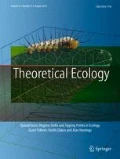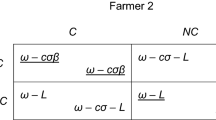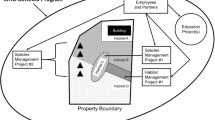Abstract
Voluntary conservation agreements are commonly used to stem the impact of habitat destruction and degradation on terrestrial biodiversity. Past studies that aim to inform how resources for conservation should be allocated across land parcels have assumed the costs of securing conservation on sites can be estimated solely on the basis of the value of alternative land uses. However, in a voluntary negotiation, a landowner could hold-out for a higher payment based on a conservation group or agency’s willingness-to-pay by leveraging the value of biodiversity on the property. We examine landowners’ ability to leverage and the consequences for conservation planning. To explore this, we first use an analytical approximation that simplifies the situation to one where a conservation group prioritizes one site for acquisition. Landowners’ ability to hold-out for higher payments in this situation ranges from approximately 17% to 55% of the value of alternative land uses on the site. We show that landowners’ ability to hold-out for higher payments is more sensitive to variance in the value of alternative land uses than variance in the biodiversity value across properties and is highest when the two factors negatively covary. Next, we consider multi-site selection decisions accounting for community complementarity across parcels. We find that leverage potential can be significantly higher in this context, with a maximum increase of 237% of the value of alternative land uses, and that community irreplaceability is correlated with landowners’ ability to leverage. If one landowner holds out for a higher payment, it has implications for what other parcels should be priorities for protection.


Similar content being viewed by others
References
Acs S, Hanley N, Dallimer M, Robertson P, Wilson P, Gaston KJ, Armsworth PR (2010) The effect of decoupling on marginal agricultural systems. Land Use Policy 27:550–563
Ando A, Camm J, Polasky S, Solow A (1998) Species distributions, land values, and efficient conservation. Science 278:2126–2128
Ando AW, Shah P (2010) Demand-side factors in optimal land conservation choice. Resour Energy Econ 32:203–221
Armsworth PR, Sanchirico JN (2008) The effectiveness of buying easements as a conservation strategy. Conservation Letters 1:182–189
Arnold B, Balakrishnan N, Nagaraja H (2007) A first course in order statistics. SIAM, Philadelphia
Bode M, Wilson KA, Brooks T, Turner W, Mittermeier R et al (2008) Cost-effective global conservation spending is robust to taxonomic group. Proc Natl Acad Sci USA 105:6498–6501
Carwardine J, Wilson KA, Hajkowicz SA, Smith RJ, Klein CJ, Watts M, Possingham HP (2010) Conservation planning when costs are uncertain. Conserv Biol. doi:10.1111/j.1523-1739.2010.01535.x
Church RL, ReVelle CS (1974) The maximal covering location problem. Pap Reg Sci Assoc 32:101–118
Costello C, Polasky S (2004) Dynamic reserve site selection. Resource Energy Economics 26:157–174
Dallimer M, Acs S, Hanley N, Wilson P, Gaston KJ, Armsworth PR (2009) What explains property-level variation in avian diversity? an inter-disciplinary approach. J Appl Ecol 46:647–656
Davies ZG, Kareiva P, Armsworth PR (2010) Temporal patterns in the size of conservation land transactions. Conservation Letters 3:765–775
Dobbs TL, Pretty J (2008) Case study of agri-environmental payments: the United Kingdom. Ecol Econ 65:765–775
Dutton A, Edwards-Jones G, Strachan R, Macdonald DW (2008) Ecological and social challenges to biodiversity conservation on farmland: reconnecting habitats on a landscape scale. Mamm Rev 38:205–219
Ferrier S, Pressey R, Barrett T (2000) A new predictor of the irreplaceability of areas for achieving a conservation goal, its application to real-world planning, and a research agenda for further refinement. Biol Conserv 93:303–325
Fieller EC (1932) The distribution of the index in a normal bivariate population. Biometrika 24:428–440
Fishburn I, Kareiva P, Gaston KJ, Armsworth PR (2009a) The growth of easements as a conservation tool. PLoS ONE 4:e4996
Fishburn IS, Kareiva P, Gaston KJ, Armsworth PR (2009b) State level variation in conservation investment by a major non-governmental organisation. Conservation Letters 2:74–81
Guerrero AM, Knight AT, Grantham HS, Cowling RM, Wilson KA (2010) Predicting willingness-to-sell and its utility for assessing conservation opportunity for expanding protected area networks. Conservation Letters. doi:10.1111/j.1755-263X.2010.00116.x
Hanley N, Whitby M, Simpson I (1990) Assessing the success of agri-environmental policy in the UK. Land Use Policy 162:267–280
Hinkley DV (1969) On the ratio of two correlated random variables. Biometrika 56:635–639
Huusom H, Strange N (2008) Transaction costs economics of irreplaceability: ex ante and ex post evaluation of conservation networks vulnerability to environmental shocks. Environ Manage 41:551–565
Jack BK, Leimona B, Ferraro PJ (2008) A revealed preference approach to estimating supply curves for ecosystem services: use of auctions to set payments for soil erosion control in indonesia. Conserv Biol 23:359–367
Kleijn D, Sutherland W (2003) How effective are european agri-environment schemes in conserving and promoting biodiversity? J Appl Ecol 60:947–969
Knight AT, Cowling RM, Difford M, Campbell BM (2010) Mapping human and social dimensions of conservation opportunity for the scheduling of conservation action on private land. Conservation Letters. doi:10.1111/j.1523-1739.2010.01494.x
Latacz-Lohmann U, Schilizzi S (2005) Auctions for conservation contracts: a review of the theoretical and empirical literature. Scottish Executive Environment and Rural Affairs Department, Edinburgh
Latacz-Lohmann U, Van der Hamsvoort C (1997) Conservation contracts: a theoretical analysis and an application. Am J Agric Econ 79:407–418
McDonald-Madden E, Bode M, Game ET, Grantham H, Possingham HP (2008) The need for speed: informed land acquisitions for conservation in a dynamic property market. Ecol Lett 11:1169–1177
Meir E, Andelman S, Possingham HP (2004) Does conservation planning matter in a dynamic and uncertain world? Ecol Lett 7:615–622
Millennium Ecosystem Assessment (2005) Biodiversity and human well being. Ecological Management and Restoration 9:226–227
Murdoch W, Polasky S, Wilson K, Possingham HP, Kareiva P et al. (2007) Maximizing return on investment in conservation. Biol Conserv 39:375–388
Naidoo R, Iwamura T (2007) Global-scale mapping of economic benefits from agricultural lands: implications for conservation priorities. Biol Conserv 40:40–49
Naidoo R, Balmford A, Ferraro PJ, Polasky S, Ricketts TH, Rouget M (2006) Integrating economic costs into conservation planning. Trends Ecol Evol 21:681–687
Polasky S, Camm JD, Garber-Yonts B (2001) Selecting biological reserves cost-effectively: an application to terrestrial vertebrate conservation in oregon. Land Econ 77:68–78
Possingham H, Day J, Goldfinch M, Salzborn F (1993) The mathematics of designing a network of protected areas for conservation. In: Decision sciences: tools for today. Proceedings of the 12th National Australian Society for Operations Research Conference, Australian Society for Operations Research, Canberra, pp 536–545
Pressey RL, Johnson IR, Wilson PD (1994) Shades of irreplaceability—towards a measure of the contribution of sites to a reservation goal. Biodivers Conserv 3:242–262
Rodrigues AS, Cerdeira JO, Gaston KJ (2000) Flexibility, efficiency, and accountability: adapting reserve selection algorithms to more complex conservation problems. Ecography 23:565–574
Salzman J, Ruhl JB (2000) Currencies and the commodification of environmental law. Stanford Law Rev 53:607–694
Schilizzi S, Latacz-Lohmann U (2007) Assessing the performance of conservation auctions: an experimental study. Land Econ 83:497–515
Stoneham G, Chaudhri V, Ha A, Strappazzon L (2003) Auctions for conservation contracts: an empirical examination of Victoria’s bushtender trial. Aust J Agric Resour Econ 47:477–500
Underwood EC, Shaw MR, Wilson KA, Kareiva P, Klausmeyer KR (2008) Protecting biodiversity when money matters: maximizing return on investment. PloS ONE 3:e1515
Acknowledgements
G.D.L. was funded by a Natural Environment Research Council (NERC) Studentship. M.D. was funded as part of the UK Research Councils’ Rural Economy and Land Use Programme (RELU). RELU is a collaboration between the Economic and Social Research Council, NERC and the Biotechnology and Biological Sciences Research Council, with additional funding from Defra and the Scottish Government. Thanks also go to the authors of several studies whose data was used in the sections “Estimate of leverage potential for single site problem from empirical data” and “Multi-site selections” as well as to the two anonymous reviewers who provided valuable insights and suggestions. Finally, G.D.L would like to thank Ana Aguilar Ojeda for her helpful discussions and support throughout.
Author information
Authors and Affiliations
Corresponding author
Electronic Supplementary Material
Below is the link to the electronic supplementary material.
Rights and permissions
About this article
Cite this article
Lennox, G.D., Dallimer, M. & Armsworth, P.R. Landowners’ ability to leverage in negotiations over habitat conservation. Theor Ecol 5, 115–128 (2012). https://doi.org/10.1007/s12080-010-0103-z
Received:
Accepted:
Published:
Issue Date:
DOI: https://doi.org/10.1007/s12080-010-0103-z




